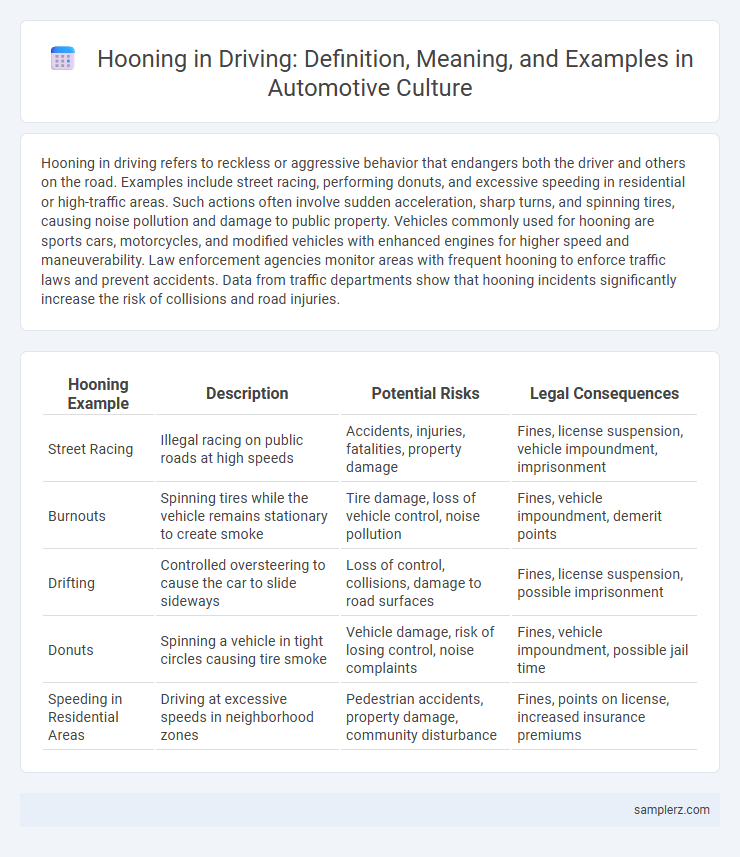Hooning in driving refers to reckless or aggressive behavior that endangers both the driver and others on the road. Examples include street racing, performing donuts, and excessive speeding in residential or high-traffic areas. Such actions often involve sudden acceleration, sharp turns, and spinning tires, causing noise pollution and damage to public property. Vehicles commonly used for hooning are sports cars, motorcycles, and modified vehicles with enhanced engines for higher speed and maneuverability. Law enforcement agencies monitor areas with frequent hooning to enforce traffic laws and prevent accidents. Data from traffic departments show that hooning incidents significantly increase the risk of collisions and road injuries.
Table of Comparison
| Hooning Example | Description | Potential Risks | Legal Consequences |
|---|---|---|---|
| Street Racing | Illegal racing on public roads at high speeds | Accidents, injuries, fatalities, property damage | Fines, license suspension, vehicle impoundment, imprisonment |
| Burnouts | Spinning tires while the vehicle remains stationary to create smoke | Tire damage, loss of vehicle control, noise pollution | Fines, vehicle impoundment, demerit points |
| Drifting | Controlled oversteering to cause the car to slide sideways | Loss of control, collisions, damage to road surfaces | Fines, license suspension, possible imprisonment |
| Donuts | Spinning a vehicle in tight circles causing tire smoke | Vehicle damage, risk of losing control, noise complaints | Fines, vehicle impoundment, possible jail time |
| Speeding in Residential Areas | Driving at excessive speeds in neighborhood zones | Pedestrian accidents, property damage, community disturbance | Fines, points on license, increased insurance premiums |
Understanding Hooning: Definition and Origins
Hooning refers to aggressive and reckless driving behaviors such as burnouts, donuts, and street racing, often performed to show off or provoke others. Originating from Australian slang in the 1980s, hooning evolved as a subculture linked to modified cars and adrenaline-fueled driving stunts. Law enforcement increasingly targets hooning due to its high risk of accidents and public safety concerns.
Street Racing: A Classic Example of Hooning
Street racing exemplifies hooning through illegal, high-speed competitions conducted on public roads, often involving dangerous maneuvers and reckless driving behaviors. Participants typically modify vehicles for enhanced performance, increasing acceleration and top speeds, which elevates the risk to both drivers and bystanders. Law enforcement agencies prioritize crackdowns on street racing due to its association with traffic violations, accidents, and public safety hazards.
Burnouts and Donuts: Reckless Stunts on Public Roads
Burnouts and donuts, common examples of hooning, involve intentionally spinning the tires to create smoke and lose traction, showcasing reckless driving behavior on public roads. These stunts not only damage asphalt surfaces but also pose significant safety risks due to loss of vehicle control and reduced visibility for other drivers. Law enforcement agencies frequently target such activities, enforcing strict penalties to deter dangerous street racing and preserve road safety.
Illegal Drag Races: Dangerous Displays of Speed
Illegal drag races, often held on public streets, involve drivers accelerating their vehicles at extreme speeds over short distances, posing significant risks to both participants and bystanders. These dangerous displays of speed lead to frequent accidents, property damage, and severe legal penalties under traffic safety laws. Law enforcement agencies increasingly deploy radar technology and undercover operations to identify and halt such reckless hooning activities.
Drifting on City Streets: Risky Automotive Maneuvers
Drifting on city streets involves intentionally oversteering to cause loss of traction in the rear wheels while maintaining control, often performed in tight urban corners or parking lots. This risky automotive maneuver increases the likelihood of accidents due to reduced vehicle stability, impaired control, and potential collisions with pedestrians or other vehicles. Law enforcement frequently targets drifting as a form of hooning, imposing heavy fines and vehicle impoundments to curb dangerous driving behaviors in densely populated areas.
Excessive Engine Revs and Loud Exhausts: Creating Public Nuisance
Excessive engine revs and loud exhausts generate significant noise pollution, disturbing residential neighborhoods and public spaces. These behaviors violate traffic regulations and increase the risk of accidents due to impaired driver control and distracted pedestrians. Law enforcement agencies actively monitor and penalize such hooning activities to maintain public safety and community well-being.
Dangerous Cornering: Showing Off for the Crowd
Dangerous cornering during hooning involves drivers aggressively taking sharp turns at high speeds to impress onlookers, often causing loss of vehicle control and increasing the risk of accidents. This reckless maneuvering not only endangers the driver but also poses significant threats to pedestrians and other road users due to unpredictable vehicle behavior. Hooning events showcasing dangerous cornering frequently result in severe vehicle damage and legal penalties as authorities crack down on public safety violations.
Obstructing Traffic: Group Hooning Events
Group hooning events often involve multiple vehicles performing dangerous maneuvers such as street racing, burnouts, and drifting that obstruct traffic flow on public roads. These activities cause significant disruption, leading to traffic congestion, increased risk of accidents, and frustration for other drivers. Law enforcement agencies frequently target such gatherings to improve road safety and reduce illegal street racing incidents.
Filming Hooning for Social Media: The Rise of Online Recklessness
Filming hooning activities such as street racing, burnouts, and drifting has surged on social media platforms like TikTok and Instagram, amplifying reckless driving behaviors among enthusiasts. These videos often showcase illegal stunts performed on public roads, leading to increased traffic hazards and legal consequences. Authorities are implementing stricter penalties and awareness campaigns to combat the glamorization of dangerous driving online.
Consequences of Hooning: Legal and Safety Implications
Hooning, such as illegal street racing or performing reckless burnouts, leads to severe legal repercussions including fines, license suspension, and potential imprisonment. These dangerous driving behaviors significantly increase the risk of accidents, causing injuries or fatalities to drivers, passengers, and pedestrians. Law enforcement agencies actively crack down on hooning to enhance road safety and reduce traffic-related fatalities in urban areas.

example of hooning in driving Infographic
 samplerz.com
samplerz.com